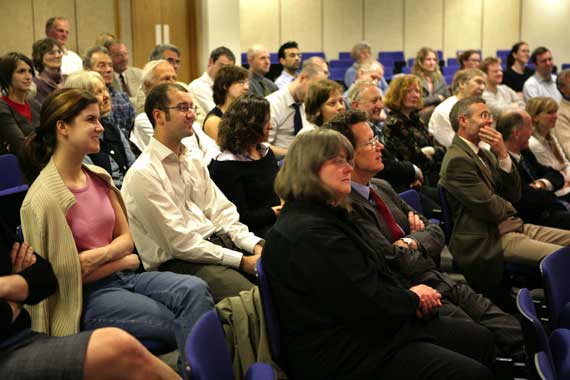|
|



The Spirit of Brunel: Collaboration, Innovation and
Pushing Boundaries |

This project consisted of a series
of talks from engineers of national and/or international eminence who
were invited to speak about innovation, technology, creativity and
collaboration. The aim was to invite engineers who have worked with
artists and architects or who are architect/engineers themselves.
Gillian Fearnyough provided the following report.
Objectives
• To highlight the value of collaboration.
• To promote the value of design and innovation.
• To assess the audience for an ongoing programme.
• To develop or build on partnerships with other organisations.
We asked speakers to talk about their work and how engineering
today can still echo the audaciousness, creativity and ingenuity that
Brunel showed. We also asked them to explore the virtues of collaboration
and how the search for new ideas inevitably means taking risks and
pushing boundaries.
We saw this event as an opportunity for the Centre
to work with engineers and emerging engineers, to attract a new audience
and to introduce the subject to a wider audience.

Events
There were 3 events in the series grouped under the global heading of The Spirit of Brunel; collaboration, innovation and pushing boundaries. Each speaker had a slightly different take on the subject and each talk was generated specifically for this series.
Professor Tony Hunt: Brunel, his contemporaries and the continuing engineering tradition
Tony Hunt is one of Britain’s most highly regarded structural engineers
who has worked with prominent architects such as Richard Rogers, Norman
Foster and Michael Hopkins. He is also the author of a number of authoritative
yet accessible books.
Tony spoke engagingly about Brunel’s adventurous spirit and his role as an entrepreneur as well as those of great engineer, innovator and inventor. Tony contrasted Brunel’s
way of working, unconstrained by the complex codes and regulations that
we have today, illustrating his talk with his own work as well as work
by well-known 20th century engineers.
Tony Hunt has wide experience in building
structures of all types and materials but his speciality is in sophisticated
steelwork, working closely with most of the leading architects in the UK
and also in France. He is first and foremost a designer and is actively
involved in the design development of projects. He lectures regularly in
the UK, Europe, USA and Canada, acts as jury member for competitions and
is a regular book reviewer.
His work has included a number of award winning
structures including Schlumberger Research Facility, Cambridge; Waterloo
International Station and The Eden Project, Cornwall.
Jim
Eye, Wilkinson Eyre and Ian Firth, Flint & Neill: Exploring
boundaries together
James Eyre, Partner and Director of Wilkinson Eyre Architects and Ian Firth,
Partner at Flint and Neill Partnership shared a platform in a live demonstration
of the value of collaboration.
Wilkinson Eyre is known for the Gateshead ‘winking eye’ Millennium Bridge, winner of the RIBA Stirling Prize (2002) and the Royal Academy of Engineering President’s
Medal (2004). The practice is engaged in an exceptionally broad range of
exciting and award wining work, including the Building Schools for the
Future programme in Bristol. Publications include 'The Architecture of
Bridge Design', Telford 1997 and 'Bridging Art and Science (the work of
Wilkinson Eyre Architects)', Booth Clibborn Editions 2001.
Flint & Neill
Partnership projects include the Tsing Ma, Kap Shui Mun and Ting Kau bridges
in Hong Kong and nearer to home the Severn, Wye, Erskine and Cleddau bridges
in the UK. Ian has also been responsible for more than 20 pedestrian bridge
designs, including the award-winning Lockmeadow footbridge, Kent.
Jim Eyre’s
approach demonstrates that the best results can be achieved where the creative
boundaries between disciplines are blurred. His talk was lively challenging
and interesting and was very well received by an audience of 51 in
the Arup auditorium, and continued after the main event.
Alistair Lenczner, Foster and Partners: The Reckless Engineer
Alistair Lenczner is Associate Partner at Foster & Partners and
since joining the company in 1998 has been involved in a number of
high profile projects.
At almost four times the height of the original,
and covering twice the area, the new Wembley Stadium will be the
largest all-covered football stadium in the world. Alistair Lenczner
has worked continuously on the project since its inception with prime
responsibilities for the stadium’s
overall planning, its geometric definition and its roof design including
the moving roof system and the giant arch supporting the roof. He also
acted as architect responsible for the Millau Viaduct in southern France
throughout its construction phase. Other profile projects include the Millennium
Footbridge London, a competition design for the new Munich Stadium and
the master-plan for the West Kowloon cultural hub project in Hong Kong.
In
the dramatic arena of the Arnolfini auditorium Alistair gave a wide ranging
talk highlighting changed ideas about risk since Brunel’s time.
Evaluation
We were pleased to get 4 extremely prestigious and high profile
speakers to come to the city. All took the subject matter seriously and
produced excellent lectures which were generally pitched at the right
level for general understanding while encompassing quite sophisticated
ideas about engineering and design.
We decided to make a small charge to make up the
short fall in funding – although
having said this we believe the charge helps give talks some status
and both ensures and controls bookings. We offered free tickets to
students.
We thought the response was reasonable, given the number of
conflicting events scheduled for this period. We believe the Architecture
Centre needs to regain a reputation for holding good talks and lectures
and this series certainly helped us to do this.”
Links
Gillian Fearnyough, Director
The Architecture Centre
16 Narrow Quay
Bristol
BS1 4QA
To find out more about the work of The Architecture Centre, its programme
of lectures and events and its conferencing facilities, visit their website at: www.architecturecentre.co.uk
Photography: Mark Simmons.
|
|